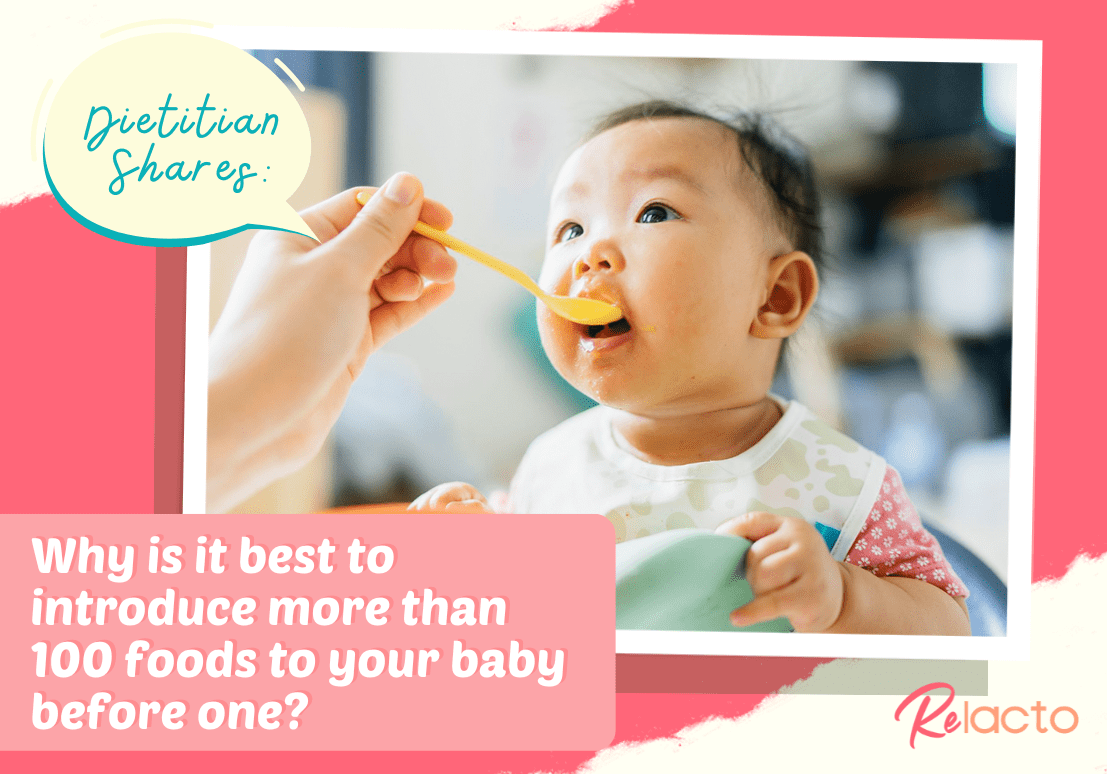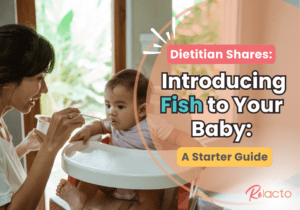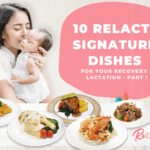Dietitian Shares: Why is it best to introduce more than 100 foods to your baby before one?

The moment you thought you just got the hang of being a mother and attending to your baby’s needs, you realized your baby is going to turn 6 months old in two weeks! Many parents think of introducing fruits and vegetables to their baby as their first few foods with really good intentions of wanting them to grow up loving their fruits and vegetables! However, the mistake is not moving forward to many other types of foods that are great and important for their baby to learn to eat!
So the idea is to introduce 100 foods before they turn 1 year old is to
- Reducing the chance of baby developing into a picky eater
- To reduce risk of developing any food allergy
- Introducing all food groups so that babies have a lesser chance of having any deficiencies, especially iron.
Many people say that the honeymoon period for complementary feeding is some time from 6 months to 1 years old. They are so curious and explorative with everything, they would put almost anything into their mouth! Their hands, their toes and even some inedible objects! I am sure you have seen babies eating tissue paper or putting their toys into their mouth. It’s all part of the development progress. So parents should take full advantage of this phase and introduce as many foods to their baby! The wider the variety, the better! As they grow older, part of normal development, babies would start expressing their likes and dislikes. They would like to have a little more control.
Another reason as to why exposing your baby to all types of foods before turning 1 year old which includes allergenic foods is because of how early exposure to such foods has been shown to allow babies to develop a tolerance and reduce risk of developing any food allergy. LEAP study is a study which studies 640 babies who had eczema or egg allergy or both, aged 4 months to 11 months at the start of the study to consume or avoid peanuts for the next 60 months. The results of the studies showed significant reduction in the frequency of development of peanut allergy among babies who consumed compared to those that avoid. Although it is not a hard and fast rule, this study was also able to show that as early as 4 months to 11 months old (which is less than 1 years old), we could do something to prevent allergies! Is it a tight window? Maybe not necessarily, but we know that it’s earlier than previous guidelines by the American Academy of Pediatrics which were to only introduce peanuts after your child turns 3 years of age. Furthermore, we should not only introduce once but we should work towards keeping these allergenic foods in their diet and expose babies to these types of food multiple times as they grow up.
There are also other compelling reasons as to why encouraging diversity in the diet to your child can be very beneficial! We all know how at 6 months of age and older, iron stores in the baby start to deplete and the iron content of the breast milk is no longer sufficient. Babies start to be at risk of being iron deficient if they do not learn how to eat iron-rich foods. This may lead to other problems like being anemic which would affect growth development and brain development. Thus, it is important for babies to learn how to eat iron-rich foods as soon as they start complementary feeding. Nowadays, there are definitely baby biscuits, cereals or rice fortified with iron that would help support this need. However, it’s important to also introduce whole foods that are naturally rich in iron too! Green leafy vegetables are a good start but it should not stop there. Foods that are rich in heme iron which is more bioavailable and easily absorbed by the baby are beef, mutton or pork! Providing them with such foods numerous times a week will help them to learn to enjoy the savoury and distinctive taste of meat which is usually an acquired taste and not as automatic as fruits which are naturally and usually sweet!
So here is a major tip on how you could work towards introducing 100 or more foods to your baby to eat before turning 1 year old! Selecting 5 new foods every week. For the next 5 days, choose 1 new protein, 1 new veg, 1 new fruit, 1 new staple and 1 allergenic food respectively, then repeat. If it helps you can always record the foods you have provided to your baby. Another additional thing you can do is prepare the same food in different textures or different cooking styles on other days! All these are part of learning and building an eater that would eat similar foods that are healthy with the family as he or she grows older.

Of course, in the first 6 months of complementary feeding, your baby will still need to rely on your breast milk for his or her main source of energy to grow. As your baby learns to eat more and more solid foods, breast milk will slowly phase from being his or her main source of energy intake to what fills in the gaps in between his or her meals. Thus, if you’re a busy mother who is already coping with work while helping your baby learn to eat solid food, signing up for a breastfeeding meal delivery can be very helpful. Relacto provides a breastfeeding food package to support you during this time. It is incorporated with traditional lactogenic ingredients into their daily meals for lactation.







